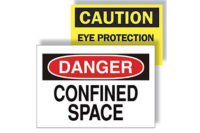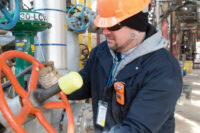Mike knew one thing going in — “One person can’t do it alone. It’s a ‘We’ concept,†he said at a ceremony earlier this year honoring him as the 2003 KellerOnline Safety Professional of the Year. (KellerOnline is an Internet-based safety management tool sold on a subscription basis by J.J. Keller & Associates, Inc.) Obviously, Mike’s story has a happy ending.
He did more than survive longer than eight months. It took a couple of years, but Mike brought the accident rate down at the Cleveland facility from a total recordable incidence rate of 12 to zero. Both plants would eventually go one year without a recordable injury.
How did he pull it off? For starters, he sold managers and supervisors on the idea that OSHA regs do not prevent injuries. It takes personal responsibility. He used the example of the McDonald’s lawsuit, where a customer sued the company after being burned by a steaming cup of coffee. Warnings aren’t enough. You have to want to protect yourself.
To drive home the message of personal responsibility, Mike pushed his “We†concept. Safety is everyone’s responsibility, and everyone needs to be involved. To build this new safety culture, employees couldn’t turn anywhere in the plant without being reminded of safety — even in the restroom. Mike relied on coworkers to market the safety message. In one instance, he had a 20-year veteran who never liked to wear his safety goggles show employees a pair covered in red ink to make the point that protection pays.
Like all good EHS pros, Mike was a change agent at Avery. He changed how the plant viewed the value and purpose of OSHA regs. Also changed how the plant viewed safety and health performance metrics — moving beyond simply measuring after-the-fact accident numbers to using leading indicators of safety activity. A scorecard tracked everyone going through the training process, equipment checks, and the frequency of five-minute safety talks. At the Cleveland plant, employees gave safety talks every day.
He took one look at the safety committee and saw it was real good at drawing up to-do lists that never got done. So he stoked committee members’ motivation by getting them involved in projects they could take ownership of, such as preparing and presenting training programs and promoting the new safety culture.
“Getting involvement was huge,†he says. “Getting employees to stand up at meetings and report what they are doing for safety is much better than having someone tell you what to do. Employees tend to listen to each other better.â€
Mike’s time and energy, use of online technical support, and outreach to management, supervisors and employees paid off. He was chosen from more than 150 finalists for the KellerOnline award for having the most well-connected, results-driven process for managing safety. Accomplishments included successful interventions in ergonomics, behavior-based safety, management training, and employee participation.
And Mike also got a promotion. He’s now in charge of six plants in North Carolina, managing safety for more than 900 Avery Dennison employees.
Worst to first
Bob Sagendorf faced a similar challenge in pulling a safety and health program up by the boot straps, and he employed some of the same strategies used by Mike Kalbaugh.When Bob was recruited by Schoonover Electric Company in Mountainside, N.J., to be corporate safety director for a virtually non-existent safety program covering all field electricians in New Jersey and Pennsylvania, his first question was: “Where do you want to be in three years?†Number One, he was told. Take us from worst to first.
Like Mike, Bob realized he couldn’t do it on his own. It would take a team effort, a culture of safety, and trust among the workforce.
Where to start? On his first day on the job, Bob turned over a five-gallon bucket, took a seat, and told employees that he would be personally responsible if they fell, got hurt, or didn’t make it home to their families. It was his first step in gaining trust and sending the message “We care.†As with Mike, the emphasis was on “we,†not “I.†It takes a team to build a culture.
It also takes actions, not words. Schoonover authorized any worker to shut down a job site at any time due to unsafe work activity or conditions. Bob’s own actions reinforce the message of trust, caring and teamwork. He shows up unannounced to perform audits, sometimes at 3 p.m. on a Friday afternoon. He catches people doing the right things and rewards them. One employee received a $50 gift card to the Home Depot for paying attention to the details — tightening rungs on a ladder.
Bob also turned his attention to management, helping them see the true cost of an injury — in terms of lower morale, replacement hires and training, job disruptions, production downtime, maybe even bad press. At weekly executive meetings, safety is now number one on the agenda.
“Being number one in the state did not happen by chance,†Bob told the audience at the KellerOnline awards ceremony, where he was honored as first runner-up. Like Mike Kalbaugh, he emphasized culture, sales and marketing, teamwork, training, and online technology. Plus old-fashioned sweat equity.


